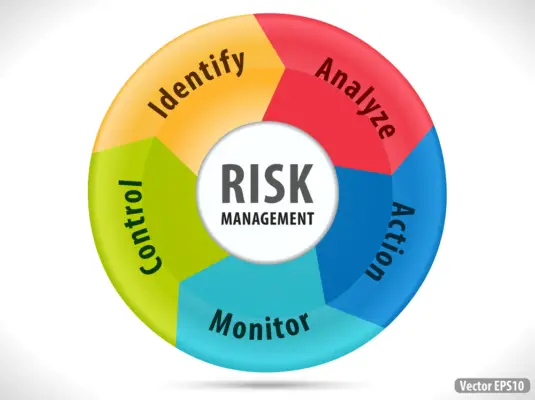Liquidity risk is the financial risk associated with a firm’s inability to execute transactions, specifically buying or selling a security or settling with counter-parties, without causing a significant movement in the price and with minimum loss of value. Essentially, it’s the risk that a firm will not be able to easily convert its assets into cash without a substantial loss in value.
Liquidity risk is typically categorized into two types:
Asset Liquidity Risk: This refers to the ease with which an asset can be sold without causing a significant movement in its price. Assets that can be sold quickly at or near their true value have high liquidity, whereas assets that cannot have low liquidity are considered illiquid.
Funding Liquidity Risk: This is the risk that an entity will not be able to meet its expected and unexpected current and future cash flow and collateral needs efficiently without affecting its daily operations or overall financial condition.
Businesses must manage their liquidity risk effectively to have enough cash to meet their short-term obligations.
Poor liquidity management can lead to significant financial difficulties and can ultimately lead to the failure of the business. Managing liquidity risk often involves maintaining adequate cash reserves, arranging lines of credit, and managing working capital effectively.
Liquidity risk is a crucial aspect of financial management that affects all types of businesses and organizations. According to a study by the Bank for International Settlements, liquidity risk was one of the primary drivers of the 2008 global financial crisis, which had far-reaching consequences on the world economy.
This statistic underscores the significance of understanding and mitigating liquidity risk to ensure stability in financial markets.
Liquidity risk also refers to the possibility that an entity may be unable to meet its short-term obligations due to a shortage of available cash or liquid assets. It can arise from market volatility, unexpected events, or poor financial planning.
Managing liquidity risk is critical for ensuring smooth operations and avoiding potential defaults or bankruptcy. This article will delve into liquidity risk, its causes and types, and strategies for managing it effectively.
Definition and Explanation of Liquidity Risk
The potential for financial institutions to encounter difficulties in meeting their obligations due to a mismatch between the timing and availability of assets and liabilities has been widely recognized by regulatory bodies.
This has led to an increased focus on managing liquidity to ensure stability and mitigate systemic risk.
Liquidity risk arises from various sources, including changes in market conditions, unexpected withdrawals by depositors, and operational failures.
Financial institutions must manage their liquidity effectively by holding adequate assets such as cash and government securities, establishing contingency funding plans, monitoring cash flows regularly, and ensuring access to emergency funding sources if necessary.
Banks and other financial institutions must understand the implications of liquidity risk since it can lead to significant losses if not managed properly.
Liquidity risk poses a serious threat to individual financial institutions and the stability of the entire financial system. Understanding its definition and implications is essential for effective management strategies to mitigate this risk.
Therefore, regulators continue to emphasize the importance of effective liquidity management practices among financial institutions as part of their efforts towards greater economic stability.
Causes of Liquidity Risk
Market Conditions: In economic downturns or financial crises, liquidity dries as investors become more risk-averse. This means that companies may have trouble selling assets without taking significant losses.
Counterparty Risk: If a counterparty fails to meet its financial obligations, this can create liquidity problems. For instance, if a bank’s borrower fails to make loan payments, the bank’s liquidity can be negatively affected.

Asset Concentration: If a firm has a concentration of assets in a particular area, and that area suffers a downturn, the firm could struggle to sell those assets and therefore face liquidity risk.
Operational Issues: Problems with a company’s internal processes or systems could lead to liquidity problems. For example, if a company’s systems don’t allow it to track cash flows accurately, this could lead to a liquidity shortfall.
Unexpected Cash Flow Changes: This could be due to a sudden large expense, such as legal expenses from a lawsuit, or a sudden drop in revenue, such as a loss of a major client. In such cases, a company may find itself in a liquidity crisis.
Lack of Access to Funding Markets: Companies may face liquidity risk if they cannot access funding markets. This can occur if lenders are unwilling or unable to provide funds, often due to concerns about the company’s creditworthiness or broader market conditions.
Currency Risk: Exchange rate fluctuations can impact liquidity for companies operating internationally. For example, if a company’s liabilities are denominated in a foreign currency that appreciates significantly, it may struggle to meet them.
Market stress is one of the main causes of liquidity risk. When there is a decline in market conditions, investors may panic and sell off their assets, resulting in decreased liquidity.
This can lead to a vicious cycle where declining prices exacerbate market stress and trigger more selling, leading to less liquidity.
Funding gaps are another factor that can contribute to liquidity risk. This occurs when an entity’s liabilities exceed its available assets, making it difficult to meet short-term obligations as they come due.
Funding gaps can arise from various reasons, such as poor cash management practices or unanticipated changes in market conditions that affect an entity’s ability to raise funds through traditional sources like banks or capital markets.
Lastly, regulatory changes also play a role in causing liquidity risk. Changes in rules governing how firms operate and manage their finances can lead to unintended consequences that reduce funding availability or increase the cost of borrowing.
For example, regulations intended to promote safety and soundness by requiring banks to hold higher reserves could limit their ability to lend and provide liquidity during times of stress.
As such, it is important for firms and regulators to carefully consider new regulations’ impact on financial markets before implementing them.
Types of Liquidity Risk
Examining the various situations in which an entity can face challenges in meeting its short-term financial obligations can provide insights into potential liquidity-related issues.
There are two main types of liquidity risk: market liquidity risk and funding liquidity risk.
Market liquidity risk refers to the inability to sell a security or asset quickly enough to meet short-term cash needs due to a lack of buyers or sellers in the market. This type of risk is often associated with illiquid assets, such as real estate or private equity investments.
Funding liquidity risk, on the other hand, refers to an entity’s inability to obtain funding from external sources when needed at reasonable costs. It arises when the lender or investor loses confidence in an entity’s ability to repay its debts, leading them to demand higher interest rates or refuse to lend altogether.
Funding liquidity risk can be caused by various factors, such as credit rating downgrades, economic downturns, and regulatory changes that limit access to capital markets.
Both market and funding liquidity risks can have severe consequences for entities that fail to manage them effectively. In extreme cases, they may lead to bankruptcy or insolvency if an entity cannot meet its financial obligations.
Organizations need to monitor their short-term cash flows carefully and establish contingency plans that prepare them for unexpected events that may affect their ability to access funds quickly and efficiently without sacrificing profitability over time.
Managing Liquidity Risk
Liquidity risk can significantly impact a company’s ability to meet these obligations, which may affect its reputation, credit rating, and even solvency. Therefore, managing liquidity risk should be a top priority for any organization.
Measuring exposure is the first step towards managing liquidity risk. Companies need to identify potential sources of liquidity risk and assess their likelihood and impact.
For example, they may consider their vulnerability to sudden changes in market conditions or unexpected events such as natural disasters. By quantifying these risks, organizations can develop appropriate strategies to mitigate them.
Implementing strategies is the second key component of effective liquidity risk management. There are various ways that companies can manage their liquidity risk, including maintaining adequate cash reserves and diversifying funding sources.
Establishing lines of credit with banks or other financial institutions and developing contingency plans for different scenarios. These strategies should be regularly reviewed and updated based on changing market conditions or emerging risks.
Effective management of liquidity risk requires careful measurement of exposure and implementation of appropriate strategies. Companies need to be proactive in identifying potential sources of liquidity risk and taking steps to mitigate them before they become critical issues.
Importance of Understanding and Mitigating Liquidity Risk
Proper risk assessment and management are crucial for organizations to avoid liquidity shortfalls resulting in bankruptcy, insolvency, or forced asset sales at unfavourable prices.
One way of mitigating liquidity risk is by maintaining adequate reserves of liquid assets, such as cash or easily marketable securities, that can be used to meet immediate funding needs.
Another approach involves diversifying funding sources so dependence on a single source is minimized and does not expose the organization’s operations to undue risks.
Understanding and mitigating liquidity risk are fundamental to managing an organization’s financial stability. Effective management requires systematic monitoring and evaluation of potential risks associated with various funding structures.
With prudent liquidity management practices, organizations can maintain their financial health even during economic turbulence or unforeseen events that could disrupt normal business operations.

Frequently Asked Questions
What are some common misconceptions about liquidity risk?
One common misconception is that liquidity risk only applies to financial institutions. However, non-financial entities are also subject to liquidity risk, as they may face difficulty meeting their financial obligations if they cannot quickly convert their assets into cash.
Another misconception is that having a large amount of cash or liquid assets eliminates the possibility of liquidity risk. In reality, even highly liquid assets can become illiquid during market stress, leading to potential difficulties in meeting short-term obligations.
Therefore, all organizations must comprehensively understand liquidity risk and its potential impact on their operations, regardless of industry or size.
How does liquidity risk differ from other types of financial risk?
Unlike credit risk, which relates to the potential for borrowers to default on their obligations, or market risk, which refers to fluctuations in asset prices due to changing conditions in the broader economy, liquidity risk concerns the ability of an institution to meet its short-term funding needs.
This can arise when there is a sudden surge in demand for cash or other liquid assets that an institution holds.
Liquidity risk differs from other types of financial risks because it primarily deals with the availability and timing of funds rather than the quality or value of assets held by an institution.
While it shares some similarities with credit and market risks, liquidity risk presents distinct challenges requiring financial institutions’ careful management and planning.
What are some potential consequences of not effectively managing liquidity risk?
Regulatory compliance is a key concern for financial institutions, and failure to manage liquidity risk adequately can lead to non-compliance and subsequent penalties.
Additionally, financial instability is a significant risk associated with poor liquidity management. Inadequate cash flow can result in an inability to meet financial obligations such as debt payments or operating expenses, leading to insolvency and potential bankruptcy.
Organisations must implement robust liquidity risk management strategies to mitigate these risks and ensure long-term viability.
Can liquidity risk be eliminated, or is it always present to some degree?
While some argue that it is possible to mitigate liquidity risk through effective management strategies, others believe that complete elimination is not feasible due to market conditions and unexpected events.
Controversial strategies have been proposed, such as reducing the proportion of illiquid assets in a portfolio or implementing strict regulations on banks’ liquidity ratios.
However, critics argue that these approaches may not be effective in eliminating liquidity risk and could potentially harm the overall performance of the financial system.
How has liquidity risk management evolved, and what are some emerging best practices?
The management of liquidity risk has evolved due to various factors, including technology’s impact and regulatory changes. With the advancement of technology, financial institutions have started using sophisticated tools to measure and manage their liquidity risks.
Additionally, regulatory authorities have introduced guidelines and regulations that require financial institutions to maintain adequate liquidity buffers and contingency plans in case of unforeseen events.
One emerging best practice is using stress testing to evaluate a firm’s resilience to different scenarios that could affect its ability to meet its obligations.
Another best practice is adopting a holistic approach that integrates liquidity risk management with other areas, such as credit risk and operational risk management.
These developments aim at ensuring financial stability by reducing the likelihood of systemic liquidity crises while maintaining sufficient liquidity levels for individual firms.

Conclusion
Liquidity risk is a crucial concept that every investor, company, and financial institution must understand. It refers to the potential of being unable to meet financial obligations due to the inability to convert assets into cash quickly or at a fair price.
Various factors can cause liquidity risk, including market volatility, operational inefficiencies, and unexpected events like natural disasters.
There are also different types of liquidity risks, such as funding liquidity risk and asset liquidity risk. Managing liquidity risk is critical for any organization’s survival and success in the long run.
Mitigating this risk includes maintaining adequate cash reserves, diversifying funding sources, and implementing contingency plans.
Managing liquidity risk effectively can lead to severe consequences such as bankruptcy or default on debt obligations.
Identifying potential risks early on and taking appropriate measures to mitigate them proactively, firms can ensure long-term viability in today’s dynamic business environment.
As such, finance professionals must take the time necessary to study this topic thoroughly to make informed decisions about their investments or operations. After all – knowledge truly is power!

Chris Ekai is a Risk Management expert with over 10 years of experience in the field. He has a Master’s(MSc) degree in Risk Management from University of Portsmouth and is a CPA and Finance professional. He currently works as a Content Manager at Risk Publishing, writing about Enterprise Risk Management, Business Continuity Management and Project Management.

